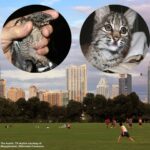
Crop Impactions, Burn throughs, And Other Crop Problems In Wild And Domestic Birds
Ron Hines DVM PhD
The scientific name for a bird’s crop is its ingluvies. The crops of all birds are an enlargement of their esophagus. In most of the bird kingdom, this sac is a poorly developed organ that rarely presents problems. But in a few species, doves, pigeons, parrots, flamingos and penguins, it is a very important, specialized organ to both the parents and their nestlings. Those are the species that present wildlife rehabilitators, avian veterinarians, aviculturists and zookeepers the most problems. Those also tend to be species that travel long distances to forage for food, so they can only feed their nestlings intermittently.
In those species, when nestling are fed, both parent birds’ crops serves a purpose similar to the breasts of female mammals. Avian crop milk production occurs under the influence of the hormone, prolactin, to produce a milky secretion of the crop’s lining cells rich in protein, fats and other nutrients, very similar to the milk produced by mammals. The exception is that crop milk is considerably lower in carbohydrate sugars.
I mentioned that both sexes produce crop milk. In doves, prolactin release is triggered by the effects of vasoactive polypeptides within the bird’s brain. (read here). Vasoactive peptides are generated in other areas of the bird as well. Their other effects include an increased inclination to build nests and a desire to incubate their eggs. (read here)
Doves cross a few sticks and call it a nest. So, their eggs and babies routinely fall out. The second photo is what came out of the egg 2.5 days later. Penguins, another crop milk feeding species, kept for your enjoyment at zoos, also abandon their eggs due to their less-than-optimal environments. I pulled that last photo from my files, a king penguin chick we hand-raised at SeaWorld.
Songbirds that feed their young primarily insects have poorer developed crops. They feed their babies throughout the day, so they don’t need a well-developed crop. Another peculiarity of birds that produce crop milk is that they tend to only lay one or two eggs per clutch. For example, 97.2% of the mourning doves studied at the USFWS Salyer refuge laid only two eggs per clutch. Two is close to the maximum number of young that their crop milk production can satisfy their nestling’s food needs for their first 1–4 days. (ask me for Blockstein1989) King Penguins, like the ones I cared for, lay only one egg per year.
In birds that do produce crop milk (such as the pigeon, but not the blue jay) the parent’s crop lining cells begins to proliferate and loosen from their attachment to the underlying tissue. When its eggs do hatch, that lining sloughs free, forming a thick slurry that the birds regurgitate to feed their chicks. Early in the chick’s life, the regurgitate is primarily made up of the parents’ own crop tissue. But as time goes by, more and more recently eaten and partially digested food is included as well. This continues in many birds even after their young have left the nest and are perching on nest-adjoining branches. The crops of crop milk secreting birds are also considerably larger than those of birds like the jay.
When parrots were the majority of birds I treated, crop burn-throughs were a significant issue. These injuries occurred because parrot breeders often fed microwaved diet formulas. Porridges, heated in microwaves, often contain crop-scalding hot spots if not well stirred. The resulting stoma openings, when small, can be sewn closed in layers. However, larger defects often required a series of repair procedures. During those recovery periods, I have the bird’s owners feed these chicks a smooth, liquefied diet through a suitably sized catheter with the tip directed gently into the thoracic inlet so that very little expansion of the crop occurs while it is healing. If that can be successfully accomplished, and if the borders of the burned area are not yet discrete and the chick maintains its body weight, many veterinarians delay repair for a few days, until it is obvious which tissue is still vital (alive) and which is not. I took the photo below of some of the catheters I use in these situations. The metal ball-tip ones are sold for drug toxicity studies in rodents that are required by the FDA. You can buy them on eBay. The disposable 3 ml pipettes are similarly available, and the intravenous catheters (with the inner needle removed) I beg from local hospitals. It pays to develop good relationships with your local hospital purchasing departments. They are also responsible for disposal of unwanted but unused supplies.
Occasionally, a crop laceration occurs when too rigid a catheter is used in syringe feeding. The young of crop milk feeding birds have a tendency to bump up against you when they are hungry. That can catch an inexperienced person off guard. Hand feeding formulas, trapped in the tissue surrounding the crop, cause severe inflammation and swelling that then gravitates to the base of their neck. I have also had to “fish” out rubber catheters that came loose from the syringe and ended up in the youngster’s crops. You can usually “milk” them back out as you would a toothpaste tube and grasp them with alligator forceps or tweezers.
Causes Of Crop Stasis – Crops That Are Too Slow To Empty Or Don’t Empty At All :
Dehydration
I placed a bag of IV fluids above because the majority of wild birds that are brought to me during the hot South Texas summers are dehydrated. Feeding them on their first day of arrival is rarely a good idea. The crops of dehydrated birds never empty well – if at all, because peristalsis is reduced or lacking along their entire digestive tract. Their bodies lack water, not salt, so I find that a lower sodium fluid, given subcutaneously, is a better option than 0.9% ringers solution. Every time you withdraw fluid from one of these bags, you run the risk of introducing bacteria into the bag. So, I aseptically transfer smaller amounts of the contents into no-additive sterile test tubes, store them in the frig, and discard whatever remains in the tube(s) I have used at the end of the day. Contamination is particularly likely to occur when IV fluids contain dextrose are entered more than once.
Sour Crop
Sour crop is a term coined by pigeon-fanciers. It can be due to a variety of issues: Too low a temperature in the youngster’s environment is one of the most common causes. Diets feed too hot or too cold is another. Diets feed in too large an amount or too infrequently is another common cause in doves, pigeons and parrots. Those fledglings can be gluttons. With time, their crop muscles stretch and can no longer contract sufficiently if they eat their fill. Residual food in the crop ferments and becomes an inviting location for parasites such as tritrichomonads and candida yeast to proliferate. When flaccid crops affect parrot chicks, a small sack (diverticulum) forms at the base of their neck that prevents their crop from fully emptying. Parrot crop “bras” and smaller, more frequent feedings help correct that. Never feed a young bird until you confirm with your fingers, before each feeding, that its crop is empty and that feces have not solidified and blocked its vent. Chicks with blocked vents will soon develop crop stasis as well. Most of those cases are due to poorly designed nesting chambers that do not allow the chicks to back up over the side of the nest when they defecate, or too low a temperature in the nursery.
Diets Fed Too Soon After Preparation
Diets fed too soon after preparation can solidify in the youngster’s crop, causing an impaction. Your formula or insect ingredients need to be about 75% water. It takes grain ingredients time to fully absorb the water that is present. I have no experience feeding dehydrated meal worms or other insects. But you want your grain-based diets to be creamy, not lumpy, and preserved insects to be fully rehydrated before you offer them.
Mild crop impactions like these can often be resolved when a small amount of warmed water is carefully syringed into the bird’s crop and gently massaged and agitated. Never suck on the syringe and catheter as you withdraw it because you can tear the chick’s delicate crop wall. Crop impactions can also be caused by grit or bedding materials. Another good reason to not use thready towels to construct artificial nests. Offer no grit to nestling. In the wild, that never happens – short of raptors offering their offspring smaller birds.
Eggs
My substitutes for crop milk always contain raw egg as a major ingredient. (read here) That is because natural crop milk and eggs contain antibodies (immunoglobulins = assorted IgGs & IGYs). (read here & here) Those antibodies are protective against a number of crop and other health issues. The natural crop milk of pigeons was reported to contains all essential amino and fatty acids, gamma globulins, vitamins, minerals and trace minerals and very little, if any carbohydrate. That is the case with poultry eggs too. Many also suspect that natural crop milk also contains protective bacteria. If the nestlings consumed their parent’s natural crop milk for their first day of life, they have already been seeded with those protective organisms. Commercial probiotics are probably of no value because firstly, many of the correct organisms are species-specific, and secondly, important ones are anaerobic and/or impossible to cultivate in bulk. I believe that a much better alternative would be a throat-to-throat swab from a healthy adult bird with a similar natural diet. I have never attempted that, even in doves that arrived in their eggshells. But I am usually feeding many baby doves from the same food batch or in close proximity, something that is probably equally effective.
The eggshells left over get ground into a fine calcium powder with my Krups coffee grinder and added to the diets of various wildlife.
Do Some Of These Crop Impactions Require Surgery?
Yes
The procedure is called an ingluviotomy.
What Instruments Might My Avian Veterinarian Use?
I became spoiled when I worked for the NIH. One of my many jobs was maintaining the Institute’s pathogen-free chicken egg production for yellow fever vaccine development. Nothing was too expensive or too unlikely to get used for us to buy. In fact, I was told in no uncertain terms to spend every penny of my current year’s budget to prevent the next year’s allocation from being less. Those times are lone passed. Today, I use the instruments you see in the second photo, lower quality Pakistani-made knock offs of the high-quality German castroviejo ophthalmic instruments you see in the first photo. You can purchase those lower quality instruments on eBay for ~$160. The German-manufactured ones will cost you four times that amount. Never leave them in a solution that contains Cidex™ type products, or ordinary steel objects, or they will pit or rust. If you want to read more about how avian surgery is performed at veterinary centers specializing in it, ask me for Guzman 2016.
That’s Not An Option For Me, What Instruments Might A Wildlife Rehabilitator Like Me Use?
I thought about that and set what you will need on my surgery table in the photo above. First, you need to acquaint yourself with bird anatomy. Wildlife rehabilitators always have birds that don’t make it. Set time aside to familiarize yourself with crop anatomy. Place objects in the crop and familiarize yourself with what they feel like when palpated through intact skin. An area needs to be plucked and sanitized. I use povidone iodine solution. You can buy a small bottle at Walmart. I should have added some vinyl gloves to the photo, but forgot to. To make your incision, I prefer a disposable scalpel with a #11 or a #15 scalpel blade. I deaden the area where I intend to make my incision with a small amount of subcutaneous 1% lidocaine you see in the glass vial, using a U-40 insulin syringe, also available at Walmart. You will have to ask your dentist for the lidocaine. Be sure it is not lidocaine with epinephrine. After the incision is made, a tiny drop of lidocaine into the incision blocks pain. A pass through a cigarette lighter sterilizes instruments, bottle tops, etc. Ear forceps or something non-pointed and similar can be used to probe for crop obstructions. The incision through the skin and through the gizzard should be quite small. Both the gizzard walls and the skin and tissue surrounding it are highly stretchable. Most objects within the gizzard can be milked out with your fingers, with the bird held in a position that allows the gizzard contents to drop to the floor. A tiny drop of superglue dropped into the incision and then pinched with your fingertips bonds the incision back together. Again, practice on some expired birds first. Count to 30 after you pinch the incision shut. Your two fingers will probably become bonded as well. I just use another clean scalpel to scrape myself free. There are cyanoacrylic medical glues available. But I have never found them superior to Super Glue™ Either product needs to be stored in the refrigerator to increase its shelf life.
The Dove That Wasn’t A Dove
A few months ago, a game warden from up Valley dropped off a paralyzed cooper’s hawk that had probably ingested bromethalin, a gasping comatose collision owl and what he had been told was an immature dove. The Coopers hawk died and the owl, placed in an oxygen tent, eventually recovered and was released. The story went that the pigeon was found that morning in the parking lot of a McAllen grocery chain by one of their employees. I explained to the warden that this was not a native dove, it was a common pigeon. When I palpated its crop, it was huge and lumpy. It felt like it was full of marbles. Nothing was in it that a momma pigeon would have conceivably fed its squabs. People who have done wildlife rehab for quite a while, like myself, all know that there are folks who drop living creatures off who cannot be relied upon to tell you the truth. They never admit that it was their cat that brought the mauled animal home. Or they tell you that they just found the bird, when actually they have had it for a couple of weeks. Their kids are tired of it now, and they leave it off with you because they see that it is fading and on death’s doorstep.
In this pigeon’s case, through ignorance or malice, someone had stuffed acorns, hard deer corn (dent corn) and dry, unhulled and hulled oats down the unfortunate bird’s throat. A few years ago, a dove chick came in with a similar problem; in that case, its crop was full of whole salted peanuts. The first image was taken the morning the pigeon came in. It also had some left side, neurological weakness that resolved over time. The second photo is of a portion of the material I surgically removed. The third photo is of the area of the incision – fully healed 7 days after surgery. The incision had been closed with a drop of superglue. Young birds heal exceptionally fast when their skin, tissue and bones are returned to their proper alignment. Twenty-three days after the surgery, I was still providing it only with liquified food. Probably much longer than was necessary. The last photo was taken a month after surgery when I introduced it to its new accommodations. I supplied it with appropriate sized grit, and it eats seeds on its own now, but it still peeps and shakes, begging to be fed when I pass by. Birds and children can be slow to abandon parental nest comforts.
How It’s This Surgery Performed In Poultry?
Crop impactions sporadically occur in adult domestic poultry, such as the hen in the photo above. The most common cause that I know of is eating Bermuda grass runners. In this particular hen, and a second one the authors mention, the veterinary surgeons injected 2% lidocaine subcutaneously in the area of the planned incision. When the tangled plant material was removed, the incision was closed in two layers with absorbable suture and the chickens were sent home the same day with oral meloxicam (1 mg/kg) for pain control. The owners were advised to provide oral fluids, soaked poultry pellets and finely chopped vegetables for the next 3 – 5 days. (ask me for Lin2023)
What About Pain After Surgery?
Besides being applied topically or injected subcutaneously at the incision site, many anesthetic and calming medications, such as midazolam, diazepam and ketamine, but not lidocaine, have been said to be effective when administered to birds intranasally (as nose drops). (ask me for Doss2021 & Gonzalez2022) I have no experience with that technique. If raptor anesthesia and sedation is of interest to you, ask me for Hawkins2021.
Do These Birds Need Oral Or Injectable Antibiotics?
Probably not.
Antibiotics cause collateral damage when they kill protective crop and gut flora. But I do sprinkle a small amount of cefazolin powder (as seen in the spatula) into the incised tissue as I close the wound, being careful that none of the powder enters the crop itself.
Why Pelicans?
Pelicans do not produce crop milk. They begin by feeding their offspring partially digested fish and other marine life. My arm is just long enough to reach down a brown pelican’s throat as far as its thoracic inlet. I have done that countless of times to remove fishhooks, fishing lures, and fish skeletons. Pelicans can swallow and digest large fish with ease, if the fish goes down their throat head first. But when fish are filleted on the dock, and the fish skeleton pitched back into the ocean, pelicans occasionally swallow those meaty fish skeletons with the fish’s tail end first. That blocks their esophagus and needs to be manually or surgically removed. I have also retrieved blocking plastic ziploc bags of bait that greedy pelicans snatched from fishermen. Pelican pouch lice are surprising quick to attach to your arm and hang on tight when your arm is down a pelican’s throat. A dose of ivermectin (200 µg/kg) injected into a fish and pitched to a pelican destroys those lice, but that takes a few days. For feather mites, I prefer to apply a topical permethrin mist.

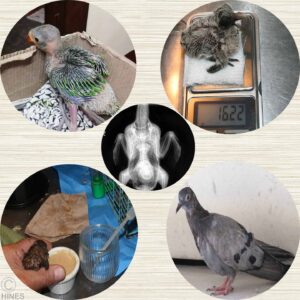
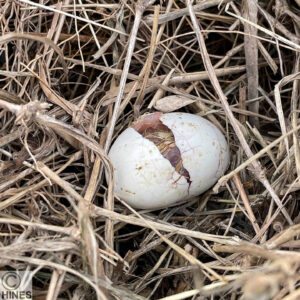
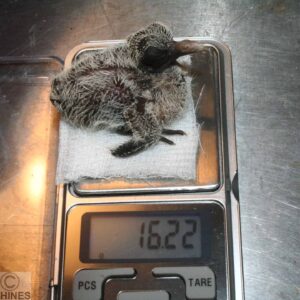
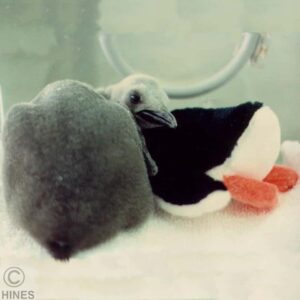
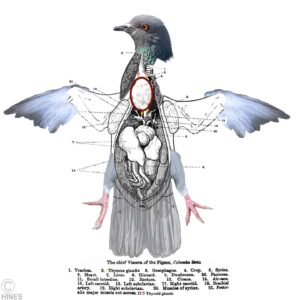
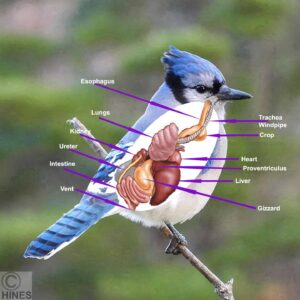
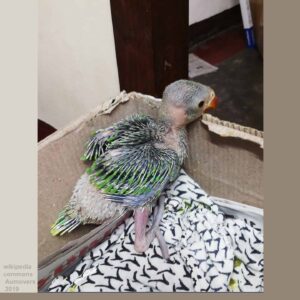
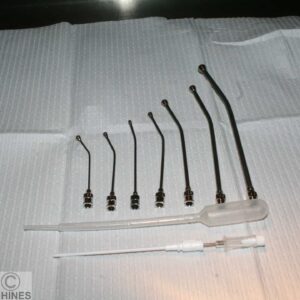
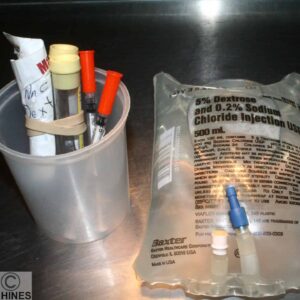

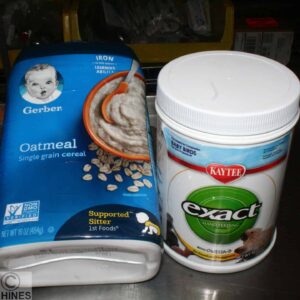
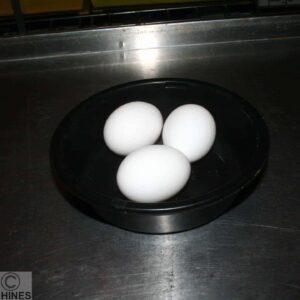
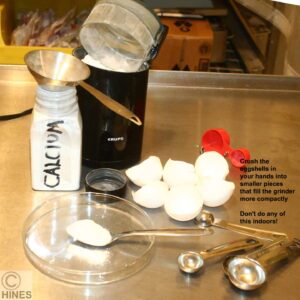
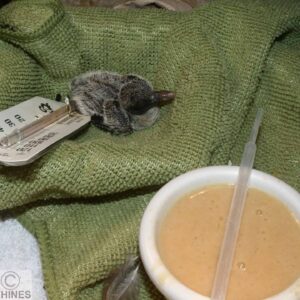
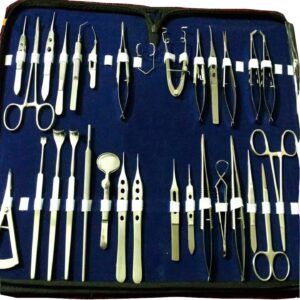
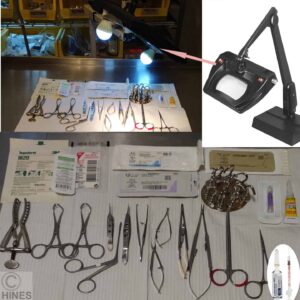
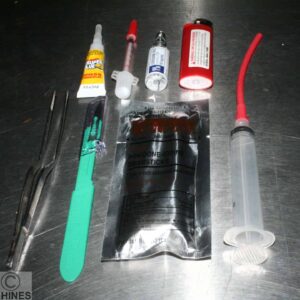
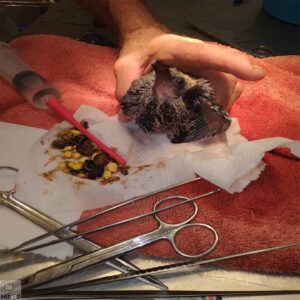
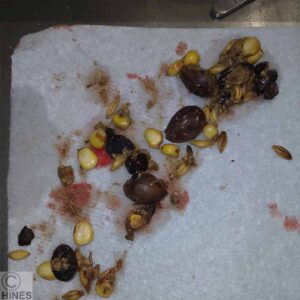
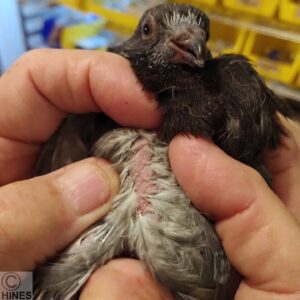
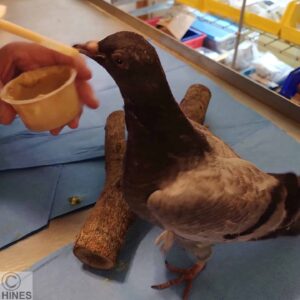
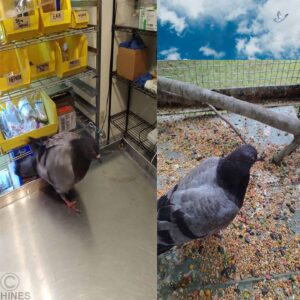
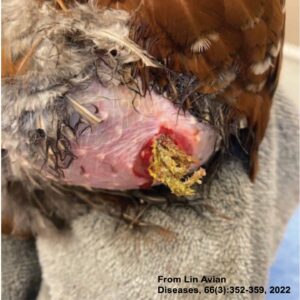
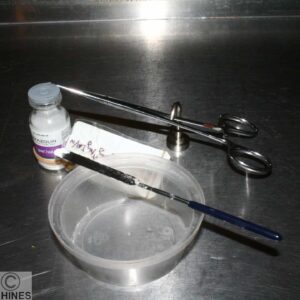
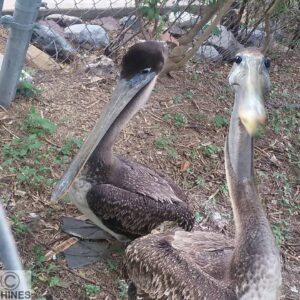
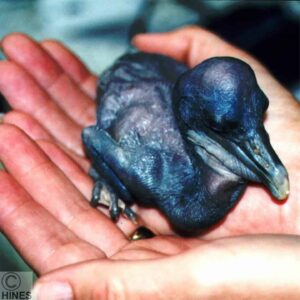
 Dear reader, Besides your donations, Visiting the products that Google chooses to display on this webpage helps me pay the cost of keeping this article on the Web. As you know, sites like mine that are not designed to make money are getting harder and harder to find. Best wishes, Ron Hines
Dear reader, Besides your donations, Visiting the products that Google chooses to display on this webpage helps me pay the cost of keeping this article on the Web. As you know, sites like mine that are not designed to make money are getting harder and harder to find. Best wishes, Ron Hines